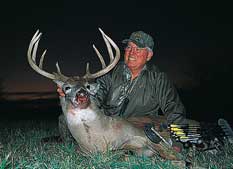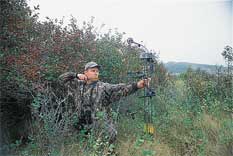I am more of a gun hunter than a bow hunter, however none of the deer I have ever shot with a replaceable blade fixed broad head have been lost. I started out years ago with the original 3 blade Wasp head and have since also used Muzzy 3 blade heads and now I have settled in on Red Head replaceable blade heads. I took a decent buck a few years ago in Madison county with the original three blade Wasp Heads. There is a Bass Pro within 40 min drive of my home and they are easy to obtain, scary sharp and fly well out of my bow.
One factor that I think some guys overlook is that if you are shooting UNDER 60 pounds like I am, mechanicals are NOT your best bet. They are also EXPENSIVE compared to heads like the Muzzy and Red Head backout. I also like the replaceable blade feature of the the Red head. I am adamant about changing blades every season and starting with scary sharp blades.
Anyway, here is a LINK to an excellent tell it like it is article by Gary Clancy:
http://www.sportsmansguide.com/Outdoors/Subject/SubjectRead.aspx?
sid=0&aid=151524&type=A
EXCERPT:
Broadheads For Deer: Mechanical Vs. Fixed Blade | |||
| Not being quick to change something that is working, mechanical broadheads did not interest me when they first came on the scene. My replaceable-blade broadheads had been doing a good job for me for a long time. Besides, many of the first mechanical heads on the market were of very poor quality. Horror stories, most of them true, abound of blades, which failed to open, blades that broke off at impact, or other mechanical failures that resulted in either lost animals or very long tracking jobs. And more than a few outfitters made it very clear that hunters shooting mechanical heads were not welcome in their camps.
Mechanical Head Users Are Lazy Still you might ask, why would anyone want to shoot a mechanical broadhead instead of a fixed blade, if they know that the fixed blade or replaceable-blade head they are currently shooting will do the job for them? As I see it, it boils down to laziness. I know that a statement like that will rile some bowhunters, but the main reason why hunters shoot mechanical broadheads is because mechanical heads fly just like field points. Sight in your bow and practice with 100-grain field points and when it is time to hunt, screw in a mechanical head of the same weight and you are ready to go. The point of impact does not change with a mechanical head. Rarely is that the case with a fixed blade or replaceable-blade broadhead. Those exposed blades act like little wings, which cause the arrow to fly differently with the broadhead attached than with the field point. This means that hunters must tune their bow to shoot broadheads accurately and must practice with broadheads before the season. This is especially true with some of the faster compounds. Mechanical heads eliminated the tune-up hassle, so bowhunters bought into the quicker, easier way. Finally Tries Mechanical Heads As mechanical heads improved, I came under increasing pressure from manufacturers, magazine editors and fellow hunters, to give mechanicals a try. After all, they argued, how can you write about something without ever having used it. So finally, I gave in and agreed to do some of my hunting with mechanical heads. For me, that turned out to be a mistake. Here is why.
Of those nine deer shot with a replaceable-head broadhead, seven were hit perfectly. And none of them went over 100 yards. One of the bucks I hit high and spined him, dropping him where he stood. I quickly put another arrow into his chest. On one of the does, my shot was a little forward of my aim point and I hit the doe square in the shoulder blade, instead of a few inches behind it where I had been holding. The arrow blew through that shoulder blade, took out both lungs and exited through the off-side shoulder blade. This has been my experience with shoulder shots on many other deer over the years. That deer too went down where she had stood. She was dead before I could slap another arrow on the string. Results On Mechanical Head Shot Deer On the first three does I shot while using mechanical broadheads, the shots were classic broadside shots. The arrow passed through all three and the blood trails were among the best I have ever seen. I've got to admit I was impressed by the results of those first three kills. The next doe I shot with a mechanical head was from a ground blind. The doe was quartering slightly away from me at a range of about 12 yards. The arrow went right where I was aiming, but lodged in the off shoulder and did not exit. Even without an exit wound, however, the deer left a good blood trail and I saw her go down about 60 yards from the Double Bull blind. Doe number five, I hit in the near shoulder blade. It was late evening and I could tell that penetration had been poor, so I left the deer until the next morning. Two hours after taking the track the next morning, I found the deer about 300 yards from where I had shot her. She was dead and judging by how stiff the carcass was, I would guess she had died early the previous evening. When I field dressed her, I found that my concern about poor penetration the previous evening had been well founded. The mechanical head, obviously slowed considerably by punching through the shoulder blade, had managed to penetrate only one lung. A deer can go a long way on one lung. The last doe I shot was captured on professional video and both the cameraman and I agreed that the shot had been "dead-perfect." We did not see the doe go down, but we were sure that we would find her within 100 yards. Unfortunately, before we could climb down and look for her, a tremendous thunderstorm blew in. Lightning, thunder and torrential rains hammered us for one-half hour. Did The Blades Open? When I pulled the arrow out of the dirt, I was dismayed to see that both of the mechanical blades were tucked back flush with the head. I hoped that the blades had folded back when they had struck the dirt, not the deer. We tried to track her in the heavy rain, but it appeared that the rain had washed away all of the blood. I found that strange, because I have tracked animals in the rain and after a rain before, and while rain certainly does dissipate the blood and make it more difficult to see, I had never before seen rain completely wash away what should have been a very good blood trail.
"It looked like the deer had been shot with a field point," were my friends exact words. Of course I cannot prove that it is the same deer, but it seems like a long-shot coincidence to me, that it would not be. I'll be the first to admit that having shot such a few number of animals with mechanical heads is far from a conclusive test. But it is darn sure good enough for this bowhunter. Will Pass On Using Mechanicals Mechanical heads are certainly much improved over what they were just a few years ago and I am certain that manufacturers will continue to make improvements upon them. It appears to me, from my limited testing and from my conversations with others who have shot mechanical heads for many years, that mechanical heads do the job when the shot is perfect. That is what concerns me most. No matter how much you practice, no matter how many 3D tournaments you win, no matter how cool you may be when drawing down on a big buck, there are still going to be times when the shot is less than perfect. There will be times when you pull the shot just a little ... when you are shaking from cold or a touch of buck fever ... when your arrow just nicks an unseen twig, or when the deer "jumps the string." Those are the times when it appears to me, that a fixed head or replaceable-blade broadhead has a better chance of getting the job done. This bowhunter will be sticking with replaceable-blade heads. I will gladly spend the extra time it takes to ensure that my broadheads fly true in exchange for the confidence I have in these heads doing their job when the shot is a little less than perfect. For a fine selection of Broadheads, click here. Gary Clancy writes a weekly column for sportsmansguide.com. Gary has hunted whitetail deer in 20 different states and provinces. He has harvested many record-book animals, and presented hunting seminars from Tennessee to Wisconsin. Gary also has authored or co-authored six hunting books, four on whitetail hunting. |




No comments:
Post a Comment